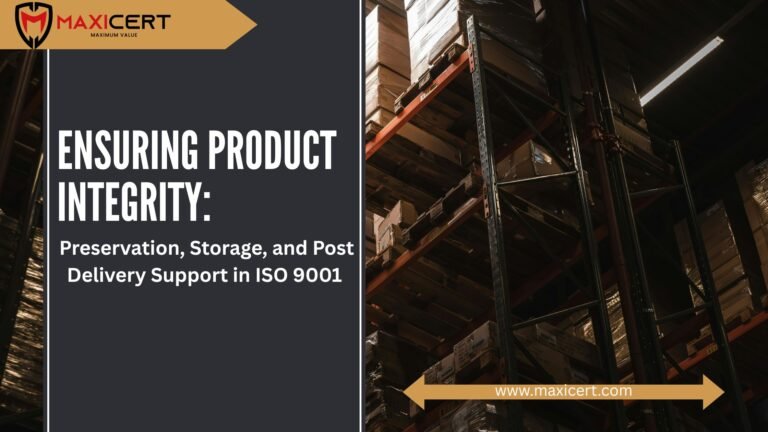Ensuring Product Integrity: Preservation, Storage, and Post-Delivery Support in ISO 9001

Introduction
Maintaining product integrity is essential for customer satisfaction and compliance with ISO 9001 standards. Clauses 8.5.4 (Preservation) and 8.5.5 (Post-Delivery Activities) emphasize the importance of proper handling, storage, packaging, and post-delivery support to ensure product quality throughout its lifecycle. This blog explores key requirements, best practices, and industry examples to help businesses implement effective preservation and support measures. Whether you’re starting your journey toward ISO certification or looking to improve existing systems, partnering with the best consultant like Maxicert can ensure you meet every ISO 9001 requirement with confidence and precision.
According to clause 8.5.4 of ISO 9001: Preservation
Depending on the nature of your organization, some or all of the requirements of this clause could apply.
Where they do apply the arrangements for handling, storage, packaging, and delivery should be appropriately documented.
You need to determine how you will ensure that these processes are properly controlled to ensure they do not have an adverse effect on product conformance.
If you produce, for example, fragile, sterile, electrostatically sensitive, or dangerous products, it is important that you ensure that activities such as identification, handling, packaging, storage and protection (which can be critical for these and other similar types of products) are actively controlled.
Request A Free Quote
There are a number of areas where handling problems can affect the quality of the product. Some examples are found in the following areas
- Most copper-based metals (e.g. copper, brass and bronze) are susceptible to corrosion from finger marks.
- Liquid-carrying tankers need to be cleaned or decontaminated prior to filling with a different liquid.
- Medical specimens need to be handled with special instruments to prevent infection.
You need to examine your own operations to determine to what extent special handling procedures are needed and to what extent they need to be documented.
Storage of particular products may also be a concern. There may be materials that are temperature or moisture sensitive or that have a limited shelf life.
Storage requirements vary from industry to industry. Examples of storage conditions include
- cold storage of food, and
- storage of magnetic media (e.g. video tapes, audio tapes and computer disks) in a non-magnetic environment.
Some products can have shelf life that could affect the product that will be delivered to the customer. Consideration should be given to ensuring that any raw materials used in the product or product that your organization produces that has a shelf life is controlled. Methods of control can be review by employees when using the raw materials or periodic checks by using expiration dates in the organization’s inventory system.
Packaging should be appropriate for the materials concerned. Bulk materials, such as sand, coal and wheat, are examples where packing consists simply of filling the carrying container. Even for such bulk transport, there needs to be a check that the container is suitable and will not contaminate the product. Large fabricated components can be simply loaded onto a truck and strapped down.
Packaging should be appropriate for the product, the intended transport, handling and storage, and the end use. Markings on packaging might need to indicate preservation requirements to the customer, e.g. temperature conditions, fragile. You should make sure that where packaging and marking materials are used, they are compatible with the products being packaged or marked. Marking materials can cause corrosion or otherwise damage products and should be selected with care.
If there are any regulatory requirements for internal processing and before and during delivery, you should be aware that there may be regulatory requirements for the after-delivery phase for the preservation of your product.
Most organizations will probably already have a stock control system. During stocktaking, it is usually possible to check the condition of products.
You need to identify the storage requirements for your products and assign appropriate storage areas. Each product does not necessarily require a separate storage area.
A periodic check of the condition of the product in stock is necessary if it is likely to deteriorate or become contaminated.
The protection of the quality of the product after final inspection and test extends to include delivery to destination. If this is to be subcontracted out, then you will have to ensure that appropriate procedures or instructions are given in order that final delivery does not affect or prevent the product (or service) from meeting customer requirements.
This could mean that you take responsibility for the transport. In such cases, you would need to be aware of any legislation or regulations, which might apply.
According to clause 8.5.5 Post-delivery activities
Many products are sold with a commitment to provide post-delivery maintenance and support as part of the overall contract. This clause applies in such instances. Remember that commitments made as part of a warranty also form part of the contract and again this clause is relevant In dealing with post-delivery activities, your process will need to address the following aspects
- general provisions of a servicing program,
- planning the servicing activities,
- what personnel are needed and any training requirements.
- spare parts management.
- preparation of servicing instructions, and
- records of servicing activities
One example of post delivery service activities is a computer retailer who provides a technical support service by telephone. In some industries, there should be consideration of the lifetime of the product or service. For example, if you have provided a service such as training to an organization and provide follow-up support after the training, is there a limit to how long after the service is provided that you continue to provide support.
When providing servicing, it is important to remember that product or service nonconformities should be fed into the corrective action system so that the reason for the failure can be identified. Remember, if warranty repairs were required, the product did not perform as intended and this is a form of nonconformity. As always, it is useful to keep records to show what you did to measure how your process was und
Conclusion
Ensuring product integrity goes beyond manufacturing—it involves careful preservation, storage, and post-delivery support. Organizations must establish clear processes to maintain product quality, comply with regulatory requirements, and enhance customer satisfaction. By implementing robust handling, packaging, and servicing procedures, businesses can minimize risks and build long-term trust with their customers. For businesses seeking ISO certification and aiming to meet the requirements of ISO 9001, working with the best consultant is essential. Maxicert offers expert ISO consulting services to help you implement, maintain, and audit effective quality management systems.

Get In Touch

Get In Touch

Get In Touch
Need A Free Estimate?
Get a free consultation and Checklist to get certified for ISO , HALAL, CE Mark Certification.
FAQ
Why is product preservation important in ISO 9001?
Product preservation prevents damage, contamination, and deterioration, ensuring products meet quality standards from production to delivery.
What are post-delivery activities in ISO 9001?
Post-delivery activities include maintenance, warranty services, technical support, and spare parts management to ensure continued product performance.
How can businesses ensure proper storage conditions for products?
Businesses should identify specific storage requirements, such as temperature control and shelf-life monitoring, and implement a periodic inspection system.



